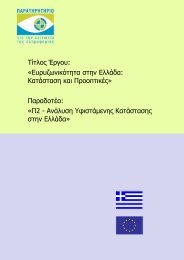Benchlearning methodology and data gathering template
Benchlearning methodology and data gathering template
Benchlearning methodology and data gathering template
- No tags were found...
Create successful ePaper yourself
Turn your PDF publications into a flip-book with our unique Google optimized e-Paper software.
D.2 “<strong>Benchlearning</strong> Methodology <strong>and</strong> Data Gathering Template”includes also indicators of performance that are not in themselves an impact, such as, forinstance, supply side <strong>and</strong> take up parameters.In this paragraph, in light of the discussion above <strong>and</strong> of the results of deliverable D.4 (deskresearch report on tax online service in EU25), we present what we consider a list of KPIsthat should be used for online tax delivery. This list is prescriptive, in the sense of ‘whatshould be’, regardless of what is available <strong>and</strong> feasible. In this sense it is worth stressing thatthis KPIs list is not related to the indicators that will be actually used for the benchlearningcases as these are selected in light of the availability of <strong>data</strong> from GSIS (see next section).In structuring such list we have included some of the indicators above into the takecategories.Supply side1. Number of services available online2. Services Score on the CapGemini Online sophistication index (1=information only; 2=download of forms; 3= two ways interaction; 4= transaction; 5= citizen centricity.)Dem<strong>and</strong> side / take up3. Total number of citizens/ businesses submitting taxes online;4. Number of unique users;5. Number of registered users;4. Number of users using more than one service;5. Amount of usage during off-hours.Comment. Indicator number 3 is the key one for the dem<strong>and</strong> side, as an internal benchmarka tax agency should consider for the use of eGovernment services in general by thepopulation. According to the last available <strong>data</strong> produced by the Observatory for the GreekInformation Society, only 3% of citizens in the relevant age group used eGovernmenttransactional services in 2006 19 . Given the importance of tax services, take up of tax onlineservices should be at least 3% of the relevant population group (15-64). From the <strong>data</strong> wehave on individual tax forms (E1), for instance, take up was 5.6% in 2006 (399.000 formssubmitted online divided by the population in age group 15-64). Considering that totalInternet penetration in Greece in 2006 was 26.5%, according to the <strong>data</strong> provided by theGreek Observatory, the relative take up ratio of tax online services among Internet users is21.1% (5.6% divided by 26.5%). This normalised figure can be used for internationalcomparison. In Italy, for instance, 2 million users directly submit tax forms online, whichamount also to 5% of the relevant population (15-64), but because the Internet penetration19 The annual measurement of the eEurope <strong>and</strong> i2010 indicators conducted by the Observatory for the GreekInformation Society, p. 3Version 123
















